If you haven’t tried sprouts yet, then it’s about time you start to enjoy their nutritional benefits and flavor. Not many people are aware that sprouts are one of the best nutrient-dense foods our planet has on offer… and they are delicious and super easy to grow!
Compared to the veggies they produce, sprouts contain up to 30 times more nutrients. They are packed with life, adding vitamins, minerals, proteins, fiber, amino acids, and oxygen. Our body needs those building blocks to function properly and protect it against toxins we are exposed to every day!
Furthermore, beans, grains, seeds, and legumes contain enzyme inhibitors and phytic acid in the outer layer to protect them from being eaten. As a result, the are hard to digest. When you soak, ferment or sprout them, these compounds or anti-nutrients will be neutralized.
When we sprout beans, grains, seeds or legumes, many beneficial phytonutrients will be produced and it also breaks down the gluten and other proteins that are harder to digest.
While our grandparents and their parents were probably familiar with sprouting, somewhere down the line people got scared of producing their own sprouts due to foodborne illnesses.
Should sprouting scare you?
Like any raw (or lightly cooked) fresh produce, sprouts can carry a risk of foodborne illness. To sprout grains, seeds, and beans you need warm and humid conditions. Unfortunately, these conditions are also the perfect breeding ground for bacteria.
Since 1996, there have been 30 reported outbreaks of foodborne illness associated with different types of raw and lightly cooked sprouts. Most of them came from places where they were mass produced. I’m not saying that you can’t have contaminations when you grow your own, but chances are pretty slim if you take some preventative measures… which are actually nothing more than working with clean materials and rinsing with clean water.
Furthermore, if you think of it, 30 outbreaks in 20 years is quite alright if you compare that with the number of people who get sick from other types of food.
Step-by-step sprouting tutorial
Most seeds, legumes, pulses, grains and some nuts can be sprouted. Since the benefits of eating sprouts have reached many people, stores are now selling expensive packets of sprouting seeds or sprouting systems or boxes.
Forget about them. A jar with a lid and a few holes is the cheap and easy option
The only thing you need is a (Mason) jar with a lid and normal seeds, grains, legumes from the supermarket or health store. They will sprout just fine for a fraction of the price. Nuts will be harder to sprout because some of them are pasteurized or treated with heat.
But let’s start sprouting! That's what we are here for!
1. Choose your bean, seed, or grain (or use more jars and do them all)
They all use the same sprouting process. I used mung beans for this tutorial but feel to experiment and use whatever you like or have at hand!
Examples
– Adzuki beans
– Mung beans
– Red/green lentils
– Chickpeas
– Green beans
– Fenugreek seeds
– Quinoa
– Buckwheat
– Alfalfa seeds
– Broccoli Seeds
Soaking times / rinsing and sprouting times:
– Adzuki beans (12 h / 3-4 days)
– Fenugreek (6 h /3-4 days)
– Chickpea (12 h / 3 days)
– Lentils (8 h / 3 days)
– Mung beans (8-12 h /3 days)
– Buckwheat (3 h / 1 day)
– Quinoa (3 h / 1 day)
– Alfa Alfa (5 h / 5-6 day)
– Broccoliseeds (5 h / 5-6 day)
2. Prepare your material
Make a few holes in the lid of the jar. Rinse the jar thoroughly with hot water. I used a quart jar (32 ounces) jar and 1/4 to 1/2 cup dried mung beans. This fills the jar to the brim with sprouts. To give you an idea sprouts can become 10 to 15 times their volume.
Rinse seeds, grains, legumes thoroughly with water.
3. Soaking process
Put the seeds, grains or beans in the jar and add FILTERED water at room temperature. Take 3 times more water than seeds, grains or beans (they will increase in volume while they soak).
FYI: For better soaking results, soak them in hot filtered water (40°C or 104°F). Mung or adzuki beans can be soaked at room temperature.
Before soaking
After soaking
4. Dark time
Depending on the type of seed, grain or legume (see above), drain water and rinse them with filtered water after a few hours of soaking and put them back in the jar without water. Put the jar in a closet or somewhere dark for 24 hours. Make sure to pick a warm spot. Don't close the jar with a lid, cover it with thin a fabric or coffee filter. Use a rubber band to hold it in place.
After 24 hours dark
Because we live in a humid and tropical climate, sprouting goes fast here. Hence their size after just one day in the dark! In a colder climate, they might look a bit different after 24 hours. So no worries. You'll just have to rinse a day or two more.
5. Rinsing
Rinse the sprouts with filtered water every 8 hours or at least twice a day. Use the lid with holes to drain the rinsing water. Leave the sprouts on the counter in a warm spot, but no direct sunlight!
After a few days (in my case only one day and night later) the sprouts will be ready for harvest. When ready, screw on the lid and store in the fridge.
Hope you liked this sprouting tutorial. Recipes with sprouts coming up next!!!

ALL CONTENT IS MINE AND ORIGINAL!
PICTURE(s) TAKEN WITH FUJI X-M1
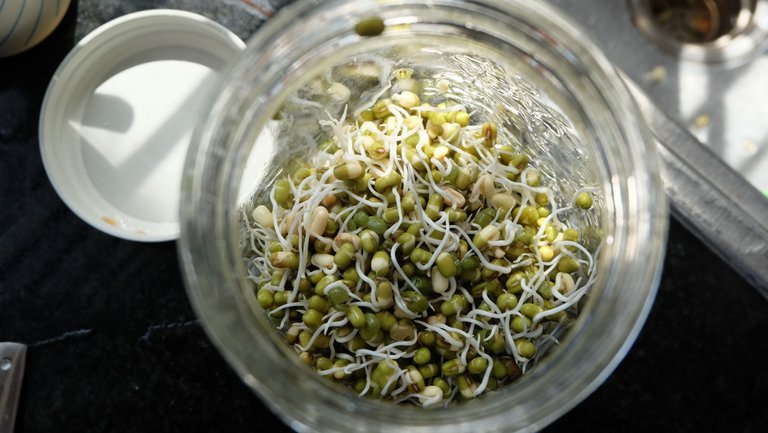

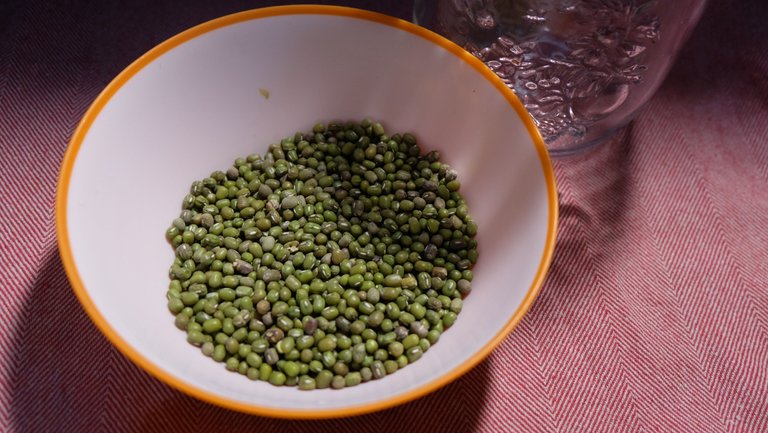

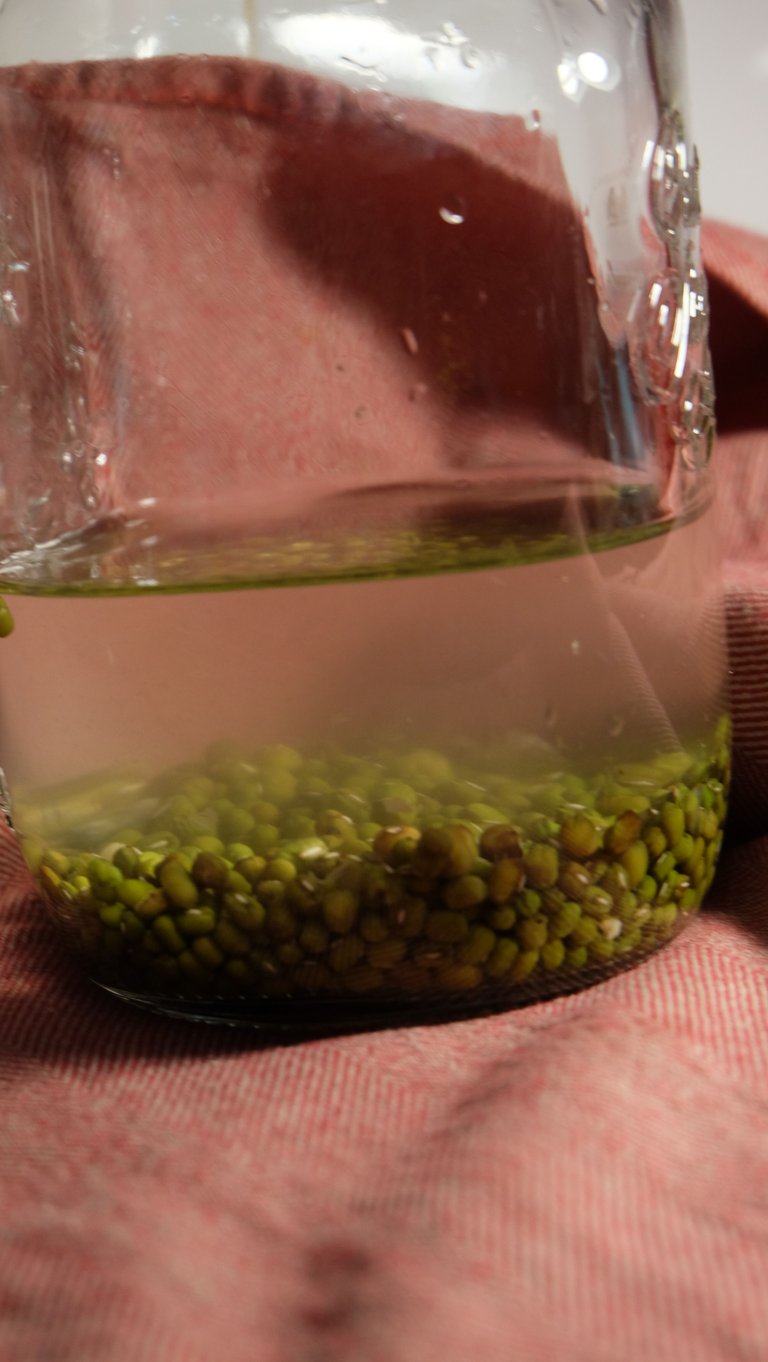
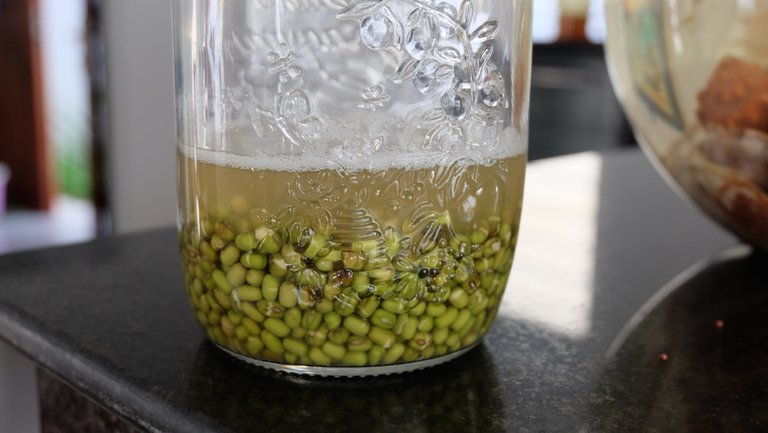
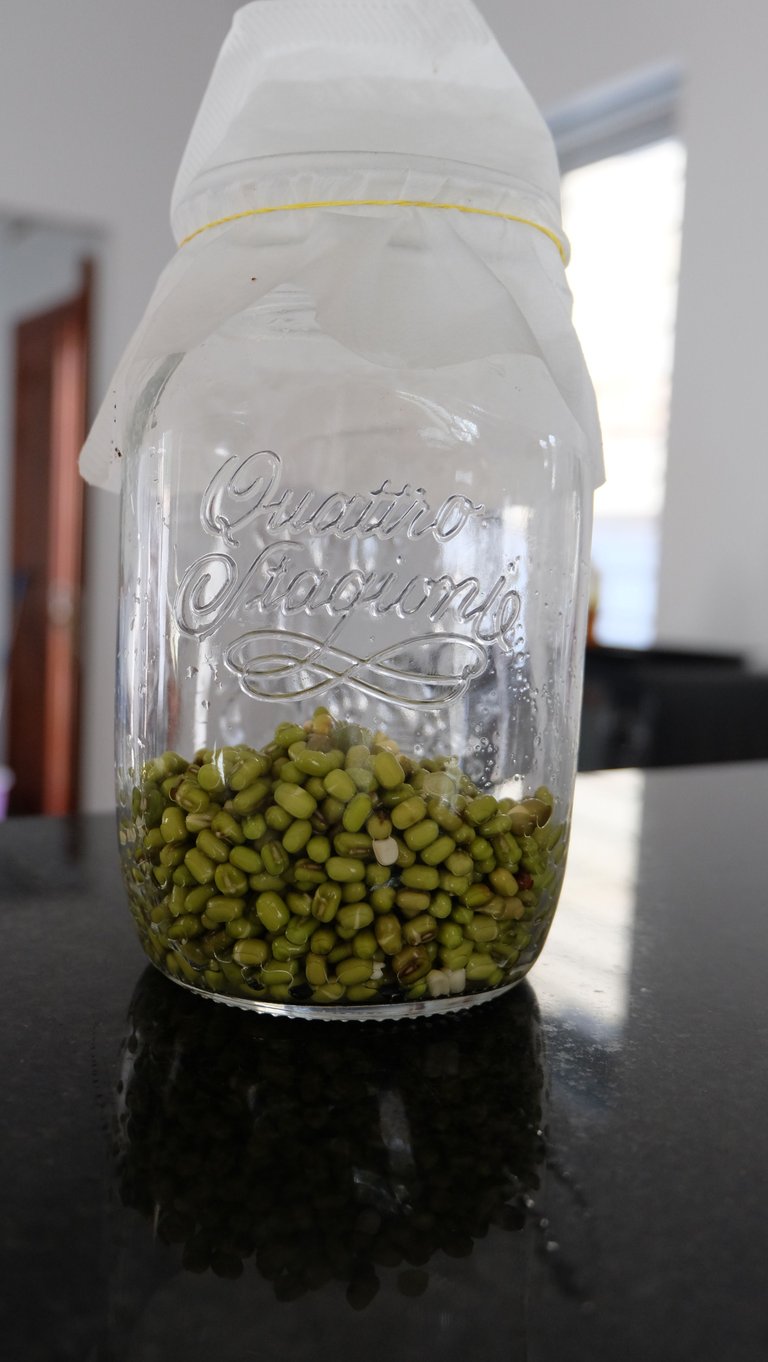
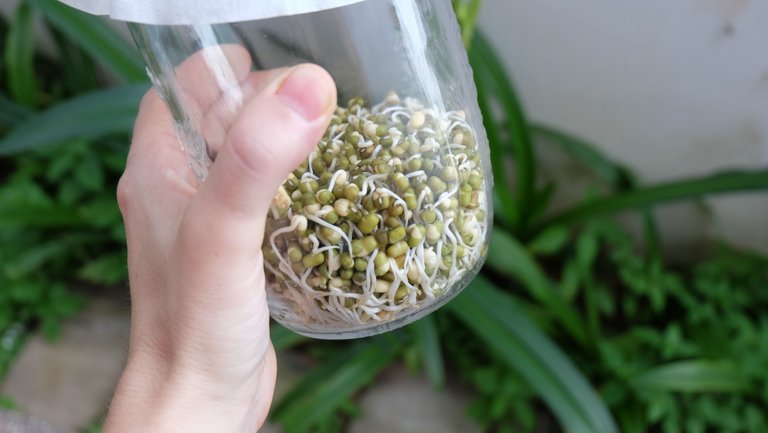
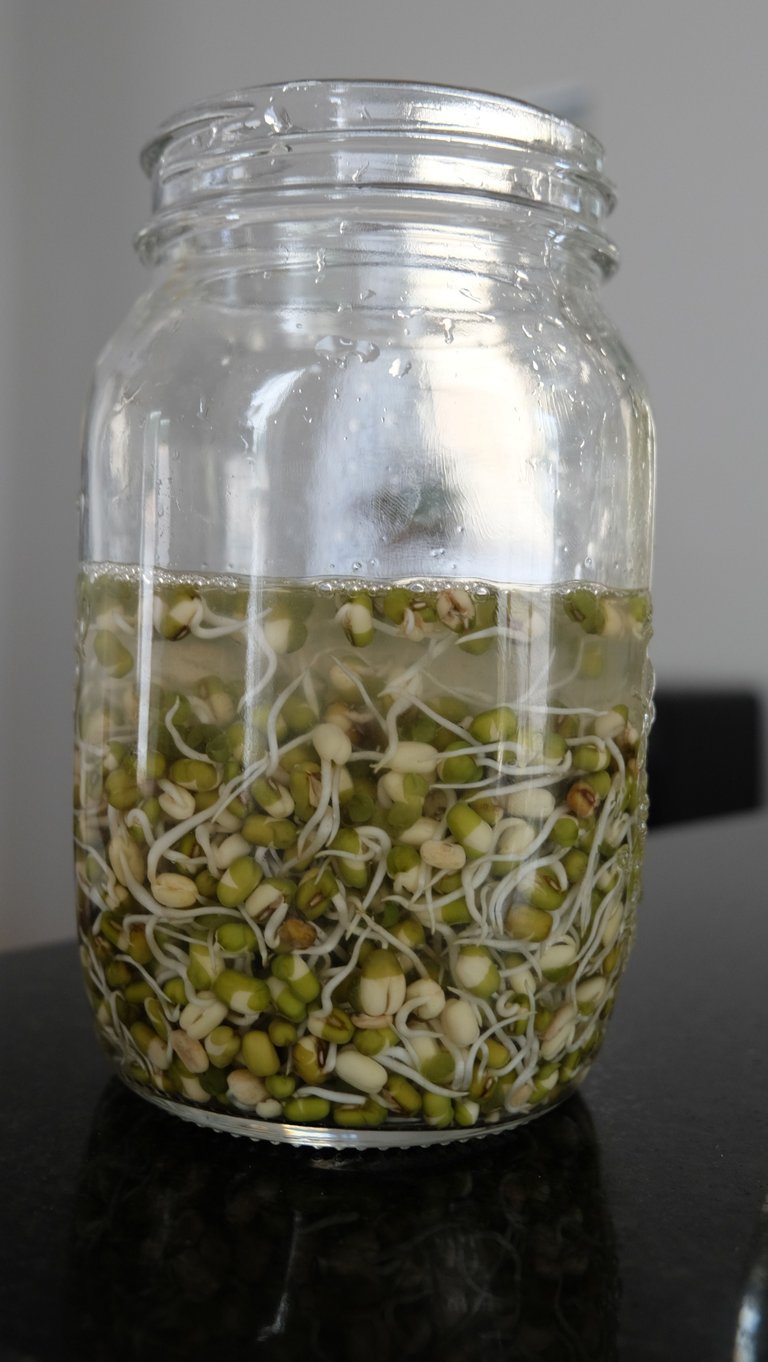
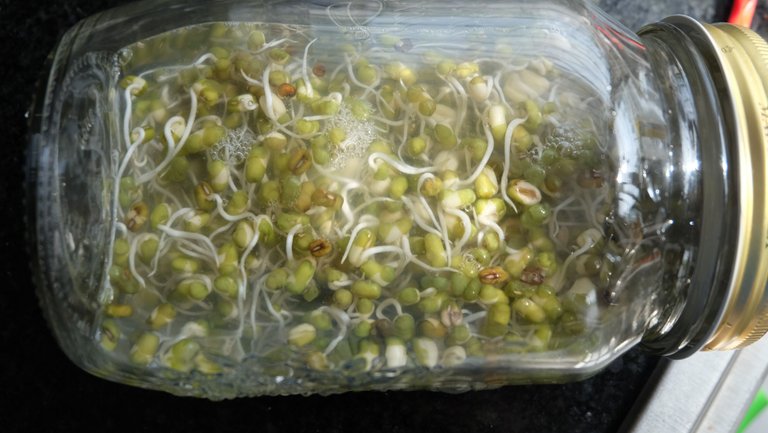
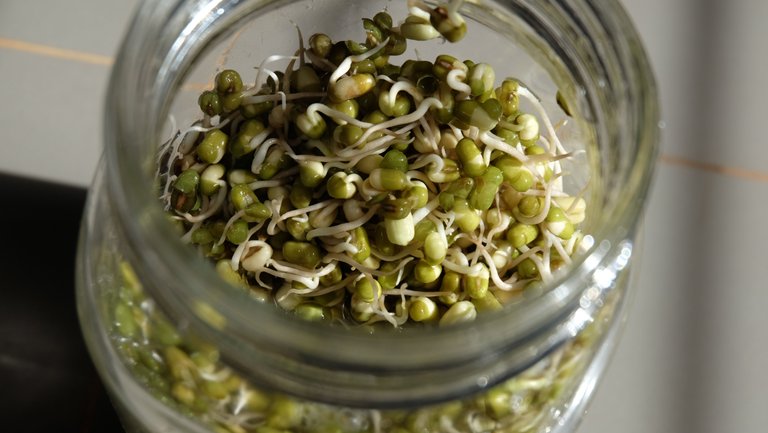
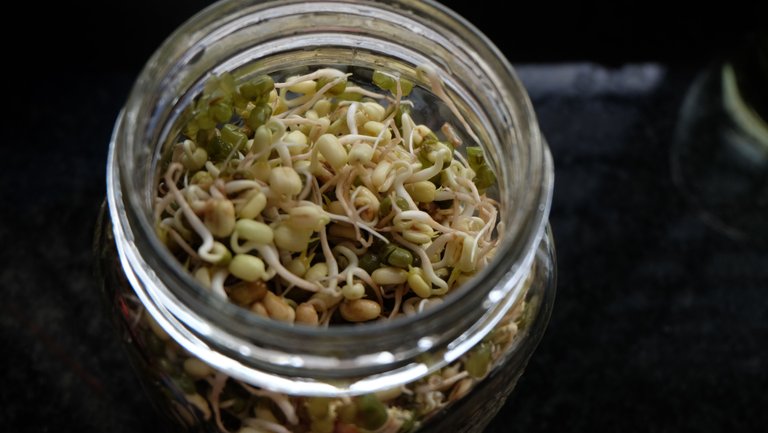
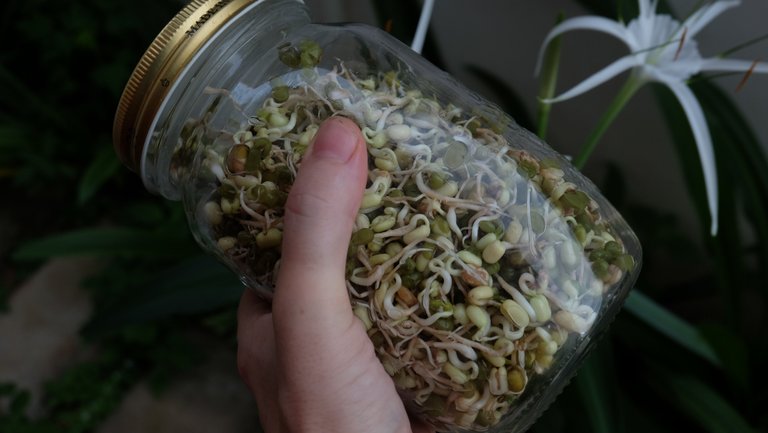
@amy-goodrich many thanks for the useful blog. It's nice to watch the pulses sprout one step at a time.
We, in India use the sprouted pulses quite regularly. It could be a plain salad or steamed with spices. Sprouted pulses are always very nutritious and tasty.
We sprout it in a different way. Old tradition handed down by grandma is that we soak the pulses overnight I.e. about 12 hours or more.
Then drain the water completely.
Then lay down a clean cotton towel on the kitchen table.
Spread the damp pulses over the towel.
Slowly wrap it and tie it tightly making a ball of it.
Tie a knot at the neck of the cotton towel ball with pulses in it.
Let it rest for about 10-12 hours.
Remove the knot and spread the towel. The pulses should be well sprouted by now ready for the salad.
It's a traditional method handed down in our family, here in India.
But then, different path leads to same destination.
Thanks for your cool post.
This is also easy to do , thank you
Thank you @topdog for the addition! Just like here in Cambodia I bet India has the right temperature for fast sprouting! I'll try your technique next time! We always have some sprouts going on.
My family and I have sprouted Alfalfa and Broccoli and both have turned out well. I was amazed at just how full the jar became, it didn't seem like we put in that many seeds for that to happen! We mainly put them on salads!
Pure magic hehehe! Same here I used so little and the jar was filled to the brim! I love Alfalfa and Broccoli sprouts too!
Yours is very nice post and very interesting I love to visit your blog. It includes useful postings. Thanks friend.
I love it.
Thank you so much @totalgyan!
This tutorial is really useful, thanks for sharing, Amy!
My pleasure @lazariko12!
Very thorough tutorial! We love sprouting for ourselves and our livestock. Up'd and resteemed :0)
Thanks @farmandadventure! We love mung and adzuki bean sprouts because they are so available and easy to sprout! Sunflower seeds are great too but they need to grow in soil for a few days too. What are your favorite grains, seeds, or legumes to sprout?
We use mung, sunflower, radish, and pea the most. I also like alfalfa for our sandwiches and pitas. I like to grow shoots as well and we eat them straight from the garden. Ok, now Im hungry!
Hehe same here! can't get enough of them! Oh I love sunflower seed sprouts too!
I use a sprouter I bought on Amazon. I sprout onions. I did not know there was a Quinoa sprout. I know there are wheat. Thanks for the info, always learning.
Never tried onions! What a great idea. Thanks for the tip! Like you mentioned always learning ;)
Thank you so much for the tutorial!
I appreciate the time you took to educate us.
I just posted a 'howto' plant potatoes in crates, it might interest you. . .
Thanks! I'm glad you like it! Thanks for dropping by and I'll have a look at the potatoes ;)
awesome thanks i do my own wheatgrass seeds like that also
Nice! They are so many wonderful foods to sprout! Thanks for your comment!
neat trick for avoiding the pricey sprouting systems. I do enjoy sprouts from time to time for a change of flavor.
Thanks, @ask-not-please! I really love them! You should try this trick some day and grow your own. nothing taste better than homegrown ;)
Yum! These look great, taste great and are sooo good for you, such a great food. Alpha alpha sprouts are my favourite bean sprouts 😋
Thanks @harrietbradley for your comment! Sprouts are indeed so good and yum!
I've tried to sprout lentils, but it didn't work out for me. I'm going to take some of your tips and hopefully it works out this time.
If you use lentils make sure it's whole ones, not the halves since they will not sprout! Also try organic, untreated varieties. Good luck!
ok. thanks. :) i'll try that next time.
Thanks so much for making people aware of this amazing superfood! I love to make sprouts myself, myfavorite are alfalfa sprouts ♥
Sprouts are indeed so good for us1 thanks @isshappy for your ongoing support and being you! Happy to know you through steemit ;)
Thank you for sharing the advice! I love sprouting mung beans but am looking to expand to more varieties. Have you tried sprouting fabric bags? I got a small hemp one to try out. Following you now and looking forward to more of your posts.
Thanks @foodisfree! I never tried sprouting fabric bags. I'll see if I can find them here. Just visited your website! Such a cool project! You have my support ;) They are creating a communal garden on the river front! It is so cool that in Cambodia you still can use open spaces and start growing food for the whole neighborhood to enjoy for free! I have an avocado tree that is almost ready to be donated to the communal garden!
That is so awesome to hear! I'd love to hear more about it or see photos of the communal garden. Maybe make a post about it sometime? One of my goals is to start a nursery to propagate fruit trees and perennial food to gift and plant everywhere. Cheers!
That's such a great idea! I sure will take some pics of the communal garden! I hope to see more of these projects along the river!
Gardens in visible spaces definitely inspire future gardens. There is something awesomely contagious about them!
Let us hope so!
Lovely explained , will try it out
It is super easy! You'll see. Good luck ;)
Plant and grow the steem. :-)
Hehe! Yummy steem is growing in the kitchen! I just started a new batch cause we nearly finished the whole pot of sprouts yesterday day ;)
More free food coming.
Cool post I enjoy eating sprouted chestnuts They fall from the trees and sprout I collect them for lunch!
Oh wow, that is so cool! When we lived in Belgium we always went to the forest with my dad to forage chestnuts. never saw sprouted ones! Nature provides us with so many yummy and free foods! Thanks for dropping by!
You are very welcome I enjoy your posts
For me it is essential to cover jar with cloth and turn it upside down so that excess water gets out while the jar remains humid.
That works too! I drilled a few holes in the lid of the jar to drain the water. Thanks for your comment and tip @m1r0!
I agree, it is very important and soak and sprout nuts, seeds, legumes and grains before we prepare them for a meal. But even when we know this, it is still challenging to do it before you get hungry!
Hehe true that! Luckily beans sprout very fast!
Awesome! My my grandma has done it before! Great tutorial! Followed you! :)
Thanks @alovelymess! Granny's are full of wisdom! My granny taught me a lot about nature and using wild foods to your advantages!
They are! Great!